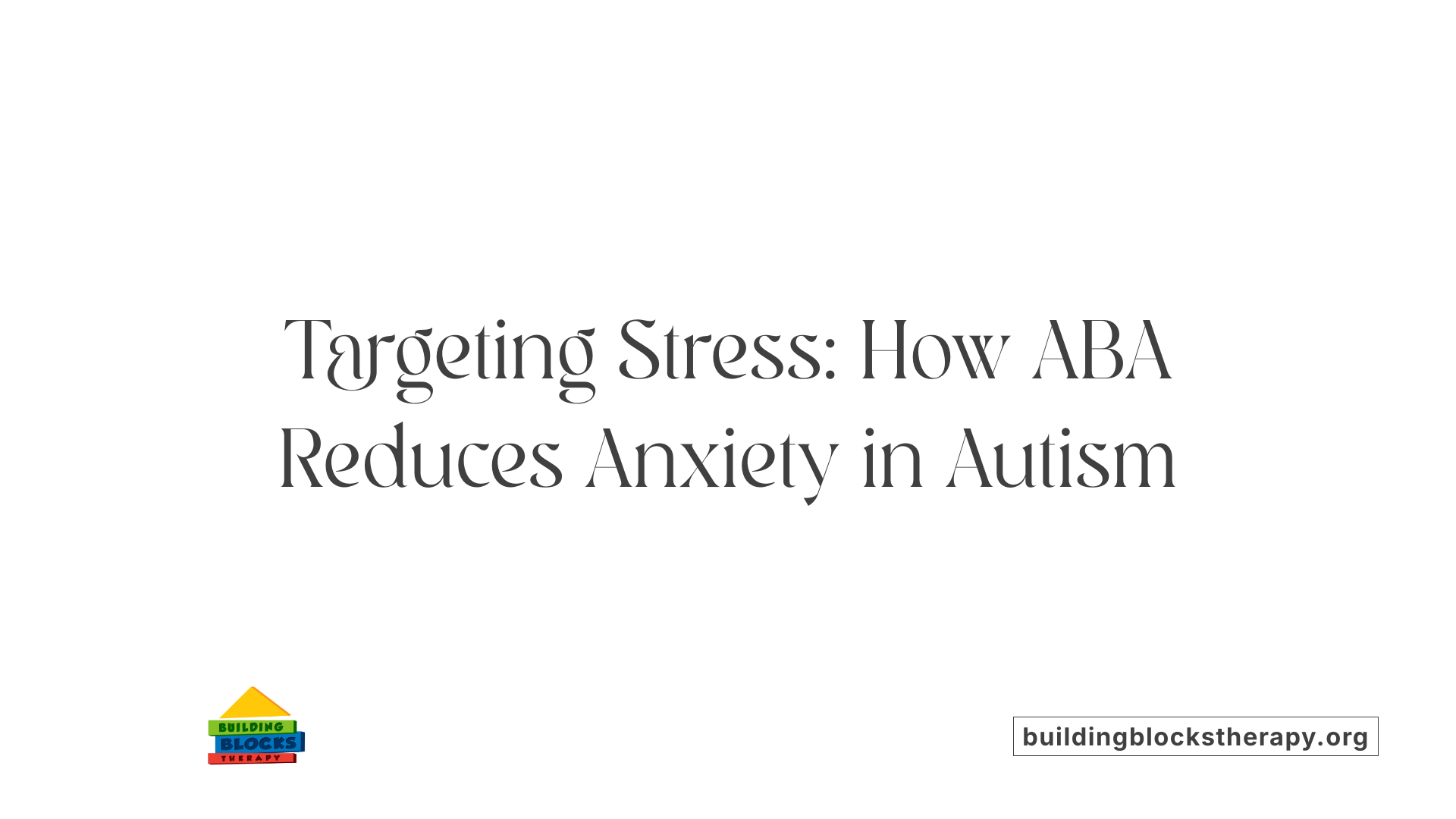Reducing Anxiety Through ABA
Understanding the Role of ABA Therapy in Managing Anxiety for Individuals with Autism

Applied Behavior Analysis: A Pathway to Reducing Anxiety in Autism
Anxiety is a common challenge among individuals with autism spectrum disorder (ASD), often complicating social interactions, communication, and daily functioning. Applied Behavior Analysis (ABA) therapy offers a structured, evidence-based framework not only to improve behavioral skills in autism but also to effectively reduce anxiety by addressing its underlying triggers. This article explores how ABA therapy helps individuals with autism manage anxiety through tailored behavioral interventions, the professionals behind the therapy, key techniques used, and the broader implications for improving quality of life.
What is Applied Behavior Analysis (ABA) Therapy and How Does it Help Individuals with Autism?

Definition and Scientific Basis of ABA
Applied Behavior Analysis (ABA) therapy is a scientifically validated method grounded in the principles of learning and behavior. It studies how behaviors are influenced by the environment and uses this understanding to develop strategies that promote positive behavioral changes in individuals with autism.
Behavioral Analysis and Positive Reinforcement
ABA therapy involves closely analyzing what happens before and after a specific behavior to determine its cause and effect. A fundamental technique in ABA is positive reinforcement, where desired behaviors are rewarded to increase their likelihood of recurring. This method helps individuals learn new skills and reduce behaviors that may be harmful or disruptive.
Individualized Approach and Settings of ABA Therapy
Each ABA program is carefully tailored to meet the unique needs, interests, and developmental levels of the individual. This personalized approach is delivered in various environments such as the home, school, or community settings, allowing therapy to fit naturally into daily life.
Focus on Communication, Social Skills, and Daily Living Skills
ABA therapy targets essential life skills including communication, social interactions, daily living, and emotional regulation. By breaking down complex tasks into manageable steps and using reinforcement strategies, individuals develop meaningful skills that enhance independence and quality of life.
Early Intervention Benefits
Starting ABA therapy early, especially intensive early interventions, can lead to significant improvements in IQ, language abilities, and adaptive behaviors in children with autism. Continuous data collection throughout treatment ensures progress is monitored and strategies are adjusted, optimizing outcomes for each individual.
Professionals Behind ABA Therapy: Expertise that Matters

Who Typically Provides ABA Therapy for Autism?
ABA therapy is delivered by a skilled team, primarily composed of Board-Certified Behavior Analysts (BCBAs) and behavior technicians (BTs). BCBAs hold advanced certifications and oversee individualized treatment plans, ensuring the methods are evidence-based and ethically applied. Behavior technicians work directly with children, implementing strategies under BCBA supervision.
How Does a Team-Based Approach Enhance ABA Therapy?
A collaborative team ensures personalized treatment by combining diverse expertise. This multidisciplinary team often includes developmental pediatricians, psychologists, and occupational therapists, all cooperating to tailor interventions to each child's unique needs. Such coordination guarantees that goals align across social communication, behavioral challenges, and daily living skills.
In What Settings Is ABA Therapy Provided?
ABA services adapt to various environments to suit the child’s comfort and requirements. Common settings include:
- In-home therapy, where children learn skills in their familiar surroundings.
- School-based programs, integrating therapy with academic goals.
- Specialized centers that offer intensive support.
- Telehealth options, facilitating remote access to therapy.
Why Is Family Involvement Important?
Strong collaboration between families and professionals forms a cornerstone of ABA therapy. Families receive training and support to maintain consistent routines and reinforce learned skills outside clinical settings. This partnership empowers caregivers to better understand autism, advocate for their child, and sustain progress over time.
| Professional Role | Responsibilities | Contribution to Therapy |
|---|---|---|
| Board-Certified Behavior Analyst (BCBA) | Develops and supervises treatment plans | Ensures evidence-based, ethical therapy tailored to child |
| Behavior Technician (BT) | Implements daily ABA interventions | Provides direct support and skill-building |
| Licensed Therapists | Offers specialized therapies (speech, OT) | Addresses co-occurring needs beyond behavior |
| Family Members | Participates in training and daily routines | Enhances consistency and generalization of skills |
This integrated approach ensures ABA therapy meets the complex demands of autism spectrum disorder, maximizing meaningful outcomes for children and their families.
Key ABA Techniques to Address Anxiety in Autism
Behavioral Assessments and Individualized Plans
ABA therapy begins with thorough behavioral assessments, including Functional Behavior Assessments (FBA). These evaluations identify triggers and consequences of anxiety-related behaviors, enabling therapists to develop personalized treatment plans that target specific needs.
Reinforcement Techniques: Positive and Negative
Positive reinforcement rewards desired behaviors to increase their occurrence, while negative reinforcement involves removing an aversive stimulus when the desired behavior occurs. Both methods are utilized strategically to help individuals with autism reduce anxiety and encourage adaptive coping behaviors.
Prompting, Fading, and Modeling
Therapists use prompting to encourage correct responses, gradually fading assistance to promote independence. Modeling demonstrates appropriate coping behaviors, giving individuals clear examples to imitate.
Functional Behavior Assessments (FBA)
FBA is a cornerstone technique that helps determine why anxiety-driven behaviors occur. Understanding the function behind behaviors allows for effective intervention strategies that replace maladaptive responses with positive alternatives.
Discrete Trial Training (DTT) and Natural Environment Teaching (NET)
DTT involves breaking learning into small, manageable tasks with structured teaching, promoting skill acquisition related to managing anxiety. NET utilizes the individual's natural surroundings to reinforce coping skills in real-life contexts, enhancing generalization.
Developing Coping Skills and Routine Building
ABA emphasizes creating consistent routines to help reduce anxiety from unpredictability. Therapists also focus on teaching coping strategies such as deep breathing or self-calming techniques, supported through positive reinforcement.
Data Collection and Progress Monitoring
Ongoing data collection ensures that interventions are effective and allows adjustments to optimize anxiety management. Monitoring progress promotes long-term success in reducing anxiety and improving quality of life.
ABA therapy integrates these methods into a compassionate, evidence-based framework tailored to each individual's challenges with anxiety, fostering resilience and improved emotional regulation.
How ABA Therapy Specifically Targets Anxiety and Stress in Autism

Understanding Internal Stress Triggers
ABA therapy begins by identifying the specific stressors affecting an individual with autism. These internal triggers may include sensory sensitivities, changes in routine, or overwhelming social situations. By observing behaviors closely, therapists can understand the root causes of stress and develop targeted interventions.
Use of Routine Building to Foster Predictability
Establishing consistent routines helps create a predictable environment, which significantly reduces anxiety. ABA techniques focus on structuring daily activities to minimize unexpected changes, providing a stable framework that helps individuals feel more secure and less overwhelmed.
Teaching Coping and Emotional Regulation Skills Through Reinforcement
ABA applies positive reinforcement to encourage the development of coping strategies. Through rewards and structured guidance, individuals learn to manage their emotions effectively, reducing stress responses and promoting emotional balance.
Enhancing Communication to Express Distress
Improving communication skills is a central goal of ABA therapy. Enhanced ability to express feelings and needs allows individuals to convey distress before it escalates, decreasing frustration and misunderstandings that contribute to anxiety.
Improving Social Skills to Reduce Isolation and Social Stress
Social challenges often lead to isolation and increased stress. ABA interventions provide social skills training to help individuals navigate social interactions more comfortably, building confidence and reducing feelings of loneliness.
Building Adaptability and Resilience to Unexpected Situations
ABA therapy fosters flexibility by teaching strategies for coping with change and unexpected events. Building resilience enables individuals to handle anxiety-provoking circumstances with greater ease and adaptability.
Overall, ABA therapy offers a compassionate and structured approach to managing anxiety and stress in autism. By addressing behavioral, emotional, and social aspects, it supports improved quality of life and emotional well-being for individuals on the spectrum.
Evaluating Effectiveness: How Progress in Anxiety Reduction is Measured
How is the effectiveness of ABA therapy assessed?
The effectiveness of Applied Behavior Analysis (ABA) therapy is assessed through a systematic approach of ongoing data collection and behavior tracking. Therapists carefully monitor targeted behaviors related to anxiety reduction, communication, and social interaction.
Ongoing data collection and behavior tracking
Data is collected continuously throughout therapy using techniques such as frequency and duration recordings. These methods quantify how often and how long certain behaviors occur, helping to identify trends in anxiety-related symptoms.
Measuring improvements in communication and social interactions
Progress is also measured by observing enhancements in communication skills—like increased ability to express feelings and reduced misunderstandings—and improvements in social behaviors such as appropriate eye contact and social engagement.
Comparing pre- and post-intervention outcomes
Initial baseline assessments are compared with data collected after interventions to evaluate gains in managing anxiety. This comparison helps determine which strategies yield the best outcomes and which areas need more focus.
Adjusting programs to optimize anxiety reduction
Based on the collected data, ABA programs are fine-tuned to better address individual needs. Targeted interventions might be intensified or modified to improve coping skills and decrease stress triggers.
Research evidence supporting ABA intensity and duration
Research shows that greater intensity and longer duration of ABA therapy correlate with more substantial improvements in anxiety management and overall functioning. Controlled studies affirm that early and consistent intervention maximizes benefits.
This structured, data-driven approach ensures that ABA therapy remains personalized and effective in reducing anxiety symptoms, enhancing quality of life for individuals with autism.
Addressing Concerns and Controversies Surrounding ABA Therapy
Are there any controversies or criticisms related to ABA therapy for autism?
Applied Behavior Analysis (ABA) therapy is widely recognized as an effective, evidence-based treatment for autism spectrum disorder. However, it has faced several criticisms and ethical concerns.
One common criticism revolves around the intensity and structure of ABA therapy. Some argue that highly structured and time-consuming interventions may feel overwhelming or restrictive for certain individuals, potentially impacting their autonomy and well-being.
Ethical debates also arise concerning the therapy's emphasis on behavior modification and compliance. Critics worry that focusing primarily on changing behaviors might inadvertently minimize the value of neurodiversity, ignoring the unique identities and preferences of autistic individuals.
Responses to ABA therapy vary greatly; not all individuals with autism find the same level of benefit, underscoring the importance of individualized treatment plans.
Due to these concerns, there is a growing movement within the ABA community to evolve practices. Modern ABA increasingly highlights compassionate, respectful approaches that honor the dignity and personal autonomy of autistic people. Therapists are encouraged to personalize interventions, prioritize collaboration with the individual and their family, and integrate flexibility to accommodate diverse needs and preferences.
Expanding the Reach of ABA: Beyond Autism and Into Daily Life
How is ABA applied to conditions beyond autism?
Applied Behavior Analysis (ABA) extends its benefits to several developmental and behavioral conditions beyond autism. For individuals with ADHD, ABA helps improve focus, impulse control, and emotional regulation by modifying behaviors effectively. Children with Down syndrome and intellectual disabilities benefit from ABA by enhancing motor skills, communication, and social interactions, which promote greater independence.
How is ABA adapted for adults and workplace settings?
ABA therapy is versatile, with adaptations suitable for adults. In workplace environments, ABA techniques focus on improving communication, time management, stress reduction, and workplace behaviors. Such adaptations help adults navigate professional demands and enhance productivity while managing behavioral challenges.
What are the benefits of ABA for time management, stress reduction, and emotional regulation?
ABA strategies help individuals develop structured routines and coping skills that improve time management and reduce stress. Emotional regulation is supported through reinforcement techniques encouraging positive behaviors and relaxation methods. These benefits contribute significantly to overall well-being and quality of life.
How can ABA strategies be integrated across different environments?
Consistency across home, school, and work environments is crucial for sustaining ABA therapy gains. Integrating ABA strategies in these settings ensures that learned behaviors and coping mechanisms are reinforced regularly. This holistic approach supports generalization of skills and promotes lasting improvements.
What role does family involvement and long-term consistency play in ABA therapy?
Whole-family involvement is essential for reinforcing ABA techniques outside therapy sessions. Parents and caregivers who learn about ABA contribute to stable routines, consistent reinforcement, and supportive environments. Long-term engagement helps maintain and build upon behavioral improvements, ensuring ongoing progress.
| Aspect | Application | Details |
|---|---|---|
| ADHD | Behavior modification, focus improvement | ABA helps manage impulsivity and improves attention through structured interventions |
| Down Syndrome & Intellectual Disabilities | Motor and social skill development | ABA enhances independence by targeting communication and daily living skills |
| Adult & Workplace | Communication, time management, stress reduction | Adapted ABA supports professional functioning and emotional health in adults |
| Environmental Integration | Consistency across settings | Reinforcement across home, school, and work maximizes therapy effectiveness |
| Family Involvement | Support and reinforcement | Engaged families enable continual practice and positive behavioral changes |
The Role of ABA in Reducing Anxiety and Enhancing Life for Individuals with Autism
Applied Behavior Analysis therapy stands as a proven, adaptable, and compassionate approach to help individuals with autism manage anxiety and improve overall functioning. Through individualized intervention plans combining behavioral assessments, reinforcement techniques, and coping skill development, ABA addresses both the outward behaviors and internal stress triggers responsible for anxiety. While it requires commitment from professionals and families alike, the therapy's evidence-backed effectiveness offers promising relief for many. By recognizing critiques and tailoring approaches to respect each individual's needs and dignity, ABA continues to evolve, fostering greater independence, resilience, and quality of life for those with autism and related developmental challenges.
References
- What Is Autism Spectrum Disorder?
- What is Applied Behavior Analysis: A Guide for Caregivers
- ABA Therapy's Role in Managing Autism-Related Stress
- 13 Applied Behavior Analysis Examples
- Is ABA Therapy Only For Autism?
- Debunking 7 Common Myths About ABA Therapy - GSEP Blog
- The effectiveness of applied behavior analysis program ...
- How to Measure ABA Therapy's Effectiveness





